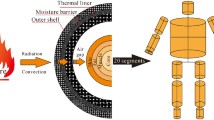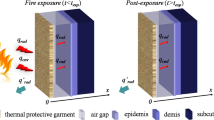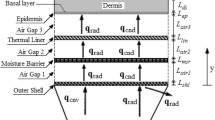Abstract
In this paper, a model of heat and moisture transport in firefighter protective clothing during a flash fire exposure is presented. The aim of this study is to investigate the effect of coupled heat and moisture transport on the protective performance of the garment. Computational results show the distribution of temperature and moisture content in the fabric during the exposure to the flash fire as well as during the cool-down period. Moreover, the duration of the exposure during which the garment protects the firefighter from getting second and third degree burns from the flash fire exposure is numerically predicted. A complete model for the fire-fabric-air gap-skin system is presented.










Similar content being viewed by others
References
Vafai K; Sözen M (1990) A comparative analysis of multiphase transport models in porous media. Ann Rev Heat Transfer 3: 145–162
Gibson PW (1996) Multiphase heat and mass transfer through hygroscopic porous media with applications to clothing materials. Technical report Natick/TR-97/005. U.S. Army Natick Research, Development, and Engineering Center, Natick, Massachusetts
Torvi DA (1997) Heat transfer in thin fibrous materials under high heat flux conditions. Ph.D. thesis. University of Alberta, Edmonton, Alberta
Pennes HH (1948) Analysis of tissue and arterial blood temperatures in resting human forearm. Journal of Applied Physiology 1: 93–122
Henriques FC Jr; Moritz AR (1947) Studies of thermal injuries I: The conduction of heat to and through skin and the temperatures attained therein. A theoretical and experimental investigation. The American J Pathology 23: 531–549
Whitaker S (1977) Simultaneous heat, mass, and momentum transfer in porous media: A theory of drying. Advances in Heat Transfer 13: 119–203
Morton W; Hearle J (1993) Physical properties of textile fibres. The Textile Institute, Manchester, UK
Catton I (1978) Natural convection in enclosures. Proceedings of the 6th International Heat Transfer Conference, Toronto 6: 13–31
Denny VE; Clever RM (1974) Comparisons of Galerkin and finite difference methods for solving highly nonlinear thermally driven flows. J Comput Physics 16: 271–284
Weaver JA; Stoll AM (1969) Mathematical model of skin exposed to thermal radiation. Aerospace Medicine 40: 24–30
Takara AN; Rouse J; Stanley T (1973) Thermal analysis program. I.I.T. research institute report IITRI-J6286. Illinois Institute of Technology, Chicago
Patankar SV (1980) Numerical heat transfer and fluid flow. Taylor & Francis, Washington, DC
Tannehill JC; Anderson DA; Pletcher RH (1997) Computational fluid mechanics and heat transfer. Taylor & Francis, Washington, DC
Torvi DA; Dale JD (1994) A finite element model of skin subjected to flash fire. J Biomech Eng 116: 250–256
American Society for Testing and Materials (1987) ASTM D 4108-87, Standard test method for thermal protective performance of materials for clothing by open-flame method. West Conshohocken, PA
Song G (2002) Modeling thermal protective outfits for fire exposures. Ph.D. thesis. North Carolina State University, Raleigh, North Carolina
Acknowledgements
The support provided by the National Textile Center is gratefully acknowledged. Helpful discussions with Profs. R. L. Barker, H. Hamouda, and Drs. D. B. Thomson and G. Song are greatly appreciated.
Author information
Authors and Affiliations
Corresponding author
Rights and permissions
About this article
Cite this article
Chitrphiromsri, P., Kuznetsov, A.V. Modeling heat and moisture transport in firefighter protective clothing during flash fire exposure. Heat Mass Transfer 41, 206–215 (2005). https://doi.org/10.1007/s00231-004-0504-x
Received:
Published:
Issue Date:
DOI: https://doi.org/10.1007/s00231-004-0504-x




